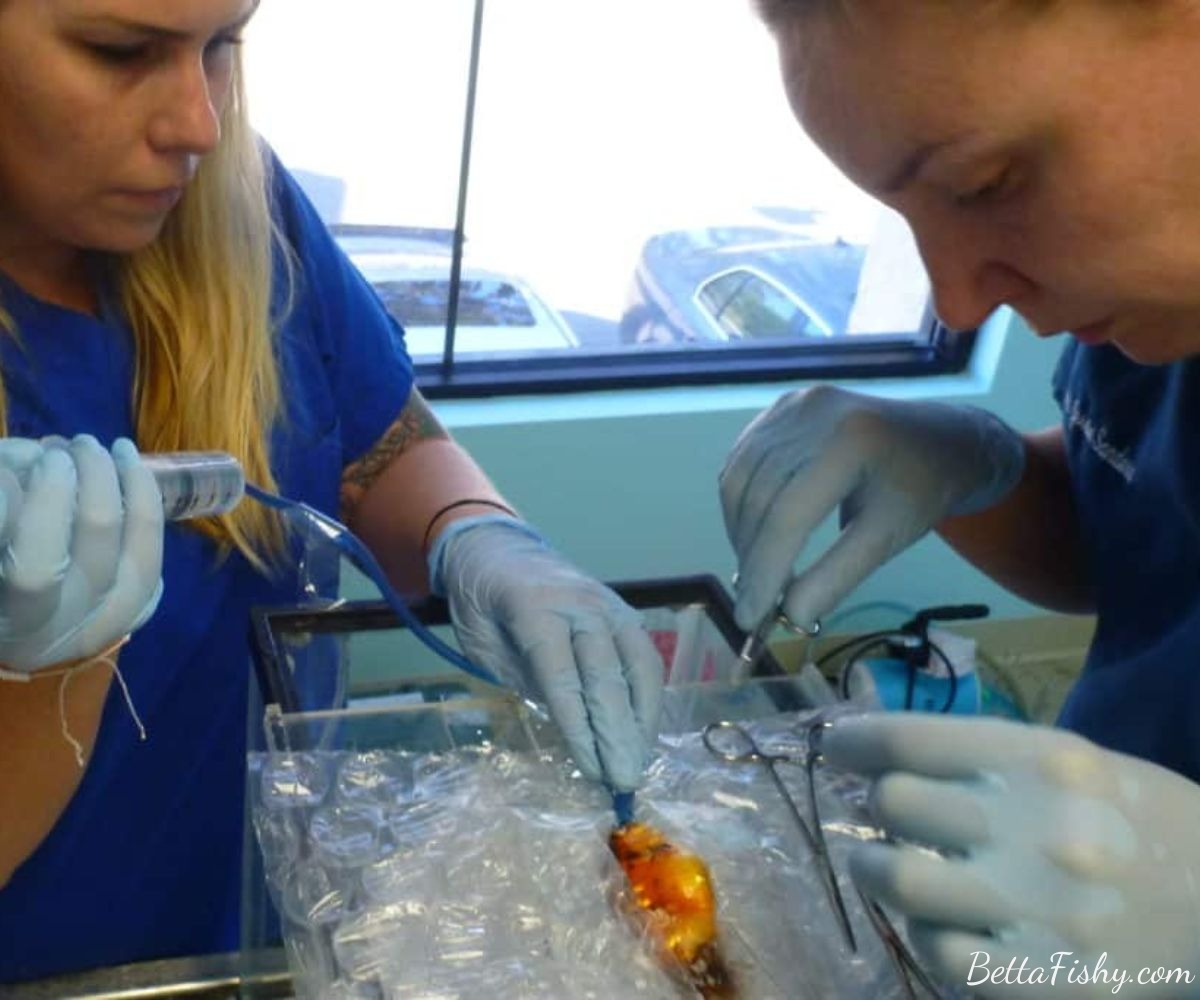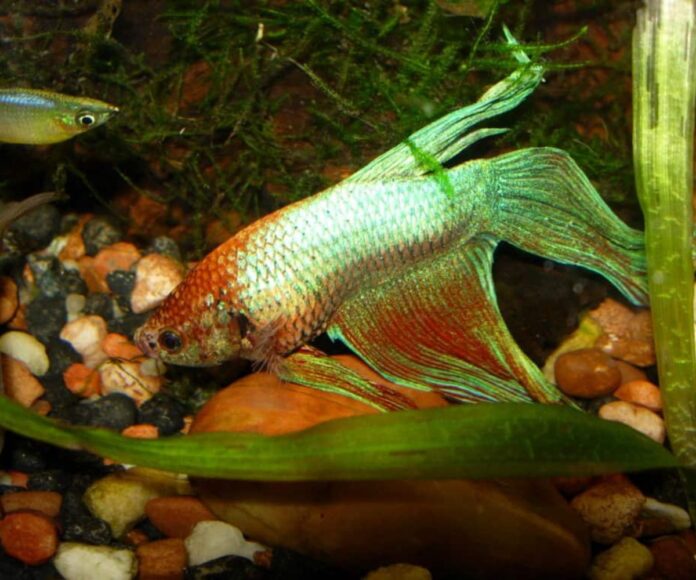Betta fish have unique reproduction processes that set them apart from other fish species. Unlike some fish, betta fish females do not get pregnant in the traditional sense. Instead, they develop hundreds of eggs in their ovaries that they release during spawning with a male. This egg-carrying stage is known as “gravidity.” It’s important for betta owners to understand the signs of gravidity in order to properly care for their fish.
Introduction
Betta fish are fascinating creatures that have captivated aquarium hobbyists for centuries. As members of the gourami family, bettas have special reproductive systems that differ from most fish. Breeders need to understand that female pregnant betta fish do not have like mammals. Instead, females develop and carry a large number of unfertilized eggs in their ovaries, a condition known as being “gravid.”
During spawning, the female betta releases her eggs, which are then fertilized externally by the male and kept in the bubble nest he constructs. This is quite different from the internal fertilization and live birth seen in mammals. Being able to identify signs of gravidity in female bettas is important for owners to properly care for them during this energy-intensive reproductive period. This article by BettaFishy will cover the key signs of gravidity and how to distinguish them from bloating or other issues.
Signs of Pregnant Betta Fish.

Female bettas exhibiting signs of gravidity, or carrying a clutch of eggs, will display some telltale physical and behavioral changes. Some of the most common signs to look out for include:
Physical Signs
Gravid female bettas often become noticeably bloated or distended on one side of their body where the eggs are developing in the ovary. You may see a large, protruding white dot near the ovipositor called the ovary containing eggs. The body coloration also tends to become much darker than normal.
Additionally, vertical white bands or stripes may appear running down the sides of the body. These breeding bars signal gravidity and are thought to help attract a male for spawning. Typically, there will be around 5-6 of these white stripes in total.
Behavioral Changes
Along with physical changes, you’re likely to observe some behavioral differences in a gravid betta. She may become lethargic and inactive as energy is directed toward developing the eggs. Appetite often decreases or ceases completely.
Gravid females tend to hide more than usual and want to be left alone. They may also display uncharacteristic aggression, especially toward male bettas. These behaviors are all natural while she is focused on reproduction and protecting the clutch.
The distinction between a pregnant fish and bloated or constipated.
It can sometimes be difficult to tell the difference between a gravid (egg-bound) female betta and one that is simply bloated or constipated. However, there are some key differences in symptoms that can help identify what’s going on:
Gravid bettas will appear swollen on one side first, then become large on both sides as more eggs develop. They tend to get very wide and boxy looking. The swelling extends down the body. They may turn darker in color and develop a noticeable white ovipositor. Gravid females also often act lethargic, hide frequently, and lose their appetite as eggs take up space inside.
Whereas females who are constipated or bloated will appear more evenly enlarged on both sides. The swelling is usually in their stomach/abdomen region. Their colors don’t change. These fish may act normal otherwise, still eating and active. Bloating can be caused by constipation from overfeeding or poor diet. If severe or prolonged, it can indicate a serious digestive issue.
You should be concerned if bloating persists for more than 2-3 days, causes loss of appetite, lethargy, or buoyancy issues. This can indicate potentially life-threatening swim bladder disease, intestinal blockages, or other problems requiring veterinary treatment. But mild, temporary bloating can often be remedied through fasting and an improved diet.
Caring for a Pregnant Betta Fish
Proper care is essential for ensuring a healthy pregnancy and successful spawning for your gravid betta. Here are some tips on setting up the right tank environment, diet, and monitoring your betta’s health:
Tank Setup
- House your gravid betta in at least a 10 gallon tank to give her plenty of room.
- Include lots of plants and hiding spots like caves and tunnels where she can rest peacefully.
- Use a tank heater to keep the water temperature between 78-80°F.
- Perform frequent water changes and test water parameters to maintain excellent water quality.
Diet
- Feed high protein foods like brine shrimp, bloodworms, and daphnia which are important for egg production.
- Offer small, frequent meals 2-3 times per day.
Monitoring
- Watch for signs of stress like clamped fins, changes in behavior.
- Make sure she is releasing some eggs each day and not becoming overly egg bound.
- Look for problems like lethargy, loss of appetite that could indicate health issues.
Maintaining excellent water quality, diet, and habitat will help support your betta through her pregnancy so she stays healthy and is prepared for spawning. Closely monitoring her condition is also important for identifying potential problems early on.
The Spawning Process

The spawning process begins once the male betta has completed building his bubble nest. At this point, the female’s body will become darker in color and her abdomen will appear swollen with eggs. She will display vertical barring on her sides as another indication of readiness to spawn.
When ready, the male will entice the female under the bubble nest with a courting display of flared gills, spread fins, and body bumping. The female will eventually turn upside down under the nest as the male wraps his body around hers in a mating embrace. She will then release 10-40 eggs which the male fertilizes by releasing milt. This cycle repeats until the female has released all her eggs, totaling 20-200 eggs overall.
After spawning, the female is removed from the tank while the male remains to care for the nest. He will gather up any eggs that fall and spit them into the bubble nest. The eggs will hatch within 24-36 hours. The tiny fry will hang vertically in the bubble nest, absorbing their yolk sacs for nourishment. After 2-3 days they will become free-swimming and the male parent will herd them back into the nest if they wander.
The fry are fed infusoria or microworms at first. Within 3-4 weeks they will be large enough to start accepting powdered fry food or crushed pellets. The juvenile bettas, called “fry”, are cared for in this way for 8-12 weeks until they reach maturity and can be separated into individual containers.
Raising the Fry
After the female betta releases her eggs and the male fertilizes them, you have a couple options for raising the fry:
You can leave the eggs with the parents for a brief time after they hatch. The fry will swim free after 2-3 days and can be left with the parents for up to 2 weeks. The parents may eat some of the fry during this time. Provide plenty of plants and hideouts in the tank so the fry can avoid the parents if needed. Closely monitor the parents to remove the fry if they become too aggressive.
Or you can remove the fry after they become free-swimming and raise them independently. Use a small tank or container with warm, clean water. Feed newly hatched brine shrimp or infusoria multiple times per day. Slowly transition to crushed flakes and pellets as the fry grow. Perform frequent water changes to keep ammonia low. The fry will be adult size in 3-4 months.
Raising the fry independently takes more effort but allows you to monitor their growth and health more closely.
Times to note when pregnant betta fish
While gravidity is a normal part of the betta reproductive cycle, there are times when you may need to be concerned about a gravid female betta fish.
One sign of trouble is if the female has been gravid for an exceptionally long time but hasn’t spawned or released her eggs. Most female bettas release their eggs within 2 weeks of becoming gravid. If it has been longer than that, she may be egg-bound and need help releasing the eggs.
You should also watch for signs of stress in a gravid betta, like clamped fins, lethargy, loss of color, or lack of appetite. These could indicate underlying health issues that need veterinary attention.
Bloating that persists more than 2-3 days or seems extreme could potentially be a symptom of a digestive disorder like constipation or an internal bacterial infection. Have a veterinarian examine any severely bloated or ill betta fish.
With proper care and monitoring, most female bettas go through the reproductive cycle without issues. But it’s important to be vigilant and involve a fish vet if anything seems abnormal or you have concerns about her health and wellbeing.
Working with a Veterinarian

While bettas are generally hardy fish, it’s still important to have an experienced fish veterinarian that you can turn to if any health issues arise. According to Dr. Krista Williams, a veterinarian specializing in fish health, “any changes in behavior or appearance could signal a problem that requires veterinary attention” (Williams).
Some signs that may indicate the need for a vet visit include lack of appetite, lethargy, bloating, growths or lumps on the body, frayed fins, gasping at the surface, or any abnormal behaviors. A vet can help diagnose the issue through a physical exam, lab tests, imaging, and other methods. They can then provide appropriate treatment which may include medications, changes in diet, or surgery in some cases.
Establishing a relationship with a knowledgeable fish vet ahead of time is recommended, so you have someone to turn to if an issue arises with your betta. They can also provide guidance on preventative care and optimizing your fish’s environment. Vet visits help ensure your betta lives a long, healthy, and happy life.
Key Takeaways
Here are the key points to remember when detecting and caring for a gravid female betta:
- Look for physical signs like a swollen belly, especially on one side, darkened body color, and a visible white ovipositor.
- Behavioral changes including lethargy, hiding, loss of appetite, and aggression can also indicate gravidity.
- A gravid belly will appear swollen all over, while bloating or constipation shows more on the sides.
- Give a gravid betta more space, plants, clean water, protein-rich foods, and monitor her closely as she nears spawning.
- Spawning involves the female releasing eggs for the male to fertilize externally. Fry hatch within 2-3 days.
Working closely with an experienced betta breeder or veterinarian is advised if you suspect your fish is gravid or encounter any issues.
Conclusion
Raising bettas can be an extremely rewarding experience for aquarium hobbyists. While uncommon, female bettas may become gravid and exhibit signs like bloating, darkened colors, and lethargic behavior. If you notice any of these symptoms in your fish, it’s important to monitor her closely and make any necessary adjustments to her diet, tank setup, and environment. Providing excellent care will help support her through the spawning process.
However, remember that pregnant betta fish are very rare. Be sure to rule out other potential causes of bloating like constipation or swim bladder disease by consulting an exotic veterinarian. Catching and addressing any underlying health issues early is key.
With attentive care and quick response if problems arise, you can help ensure a successful spawn and healthy fry. But always enlist the help of experts like your veterinarian if you have any concerns about your betta’s condition. While an exciting experience, breeding fish also brings major responsibility. Work closely with professionals to make the process smooth and keep mom and babies safe.


